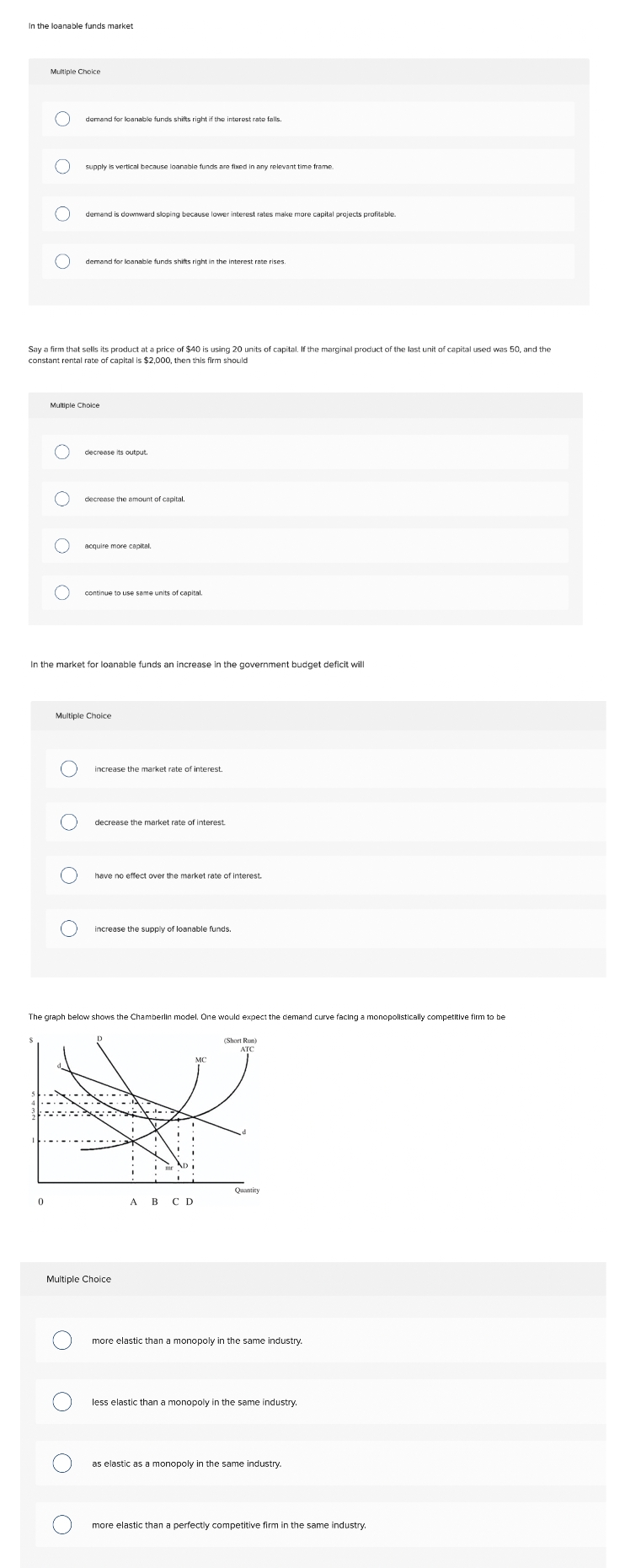In the loanable funds market Multiple Choice demand for loanable funds shifts right if the interost rate falls. supply is vertical because loanable funds are fixed in any relevant time frame. demand is downward sloping because lower interest rates make more capital projects profitable. demand for loannble funds shifts right in the interest rate rises.
In the loanable funds market Multiple Choice demand for loanable funds shifts right if the interost rate falls. supply is vertical because loanable funds are fixed in any relevant time frame. demand is downward sloping because lower interest rates make more capital projects profitable. demand for loannble funds shifts right in the interest rate rises.
Chapter16: Labor Markets
Section: Chapter Questions
Problem 16.12P
Related questions
Question

Transcribed Image Text:In the loanable funds market
Multiple Choice
demand for loanable funds shifts right if the interest rate falls.
supply is vertical because loanable funds are fixed in any relevant time frame.
demand is downward sloping because lowver interest rates make more capital projects profitable.
demand for loanable funds shifts right in the interest rate rises
Say a firm that sells its product at a price of $40 is using 20 units of capital. If the marginal product of the last unit of capital used was 50, and the
constant rental rate of capital is $2,000, then this firm should
Multiple Choice
decrease its output.
decrease the amount of capital,
acquire more capital.
continue to use same units of capital.
In the market for loanable funds an increase in the government budget deficit will
Multiple Choice
increase the market rate of interest.
decrease the market rate of interest
have no effect over the market rate of interest.
increase the supply of loanable funds.
The graph below shows the Chamberlin model. One would expect the demand curve facing a monopolistically competitive firm to be
(Short Run)
АТС
Quantity
A B C D
Multiple Choice
more elastic than a monopoly in the same industry.
less elastic than a monopoly in the same industry.
as elastic as a monopoly in the same industry
more elastic than a perfectly competitive firm in the same industry.
O O O O
O O
O O
Expert Solution
This question has been solved!
Explore an expertly crafted, step-by-step solution for a thorough understanding of key concepts.
Step by step
Solved in 2 steps

Knowledge Booster
Learn more about
Need a deep-dive on the concept behind this application? Look no further. Learn more about this topic, economics and related others by exploring similar questions and additional content below.Recommended textbooks for you


Principles of Microeconomics
Economics
ISBN:
9781305156050
Author:
N. Gregory Mankiw
Publisher:
Cengage Learning

Economics (MindTap Course List)
Economics
ISBN:
9781337617383
Author:
Roger A. Arnold
Publisher:
Cengage Learning


Principles of Microeconomics
Economics
ISBN:
9781305156050
Author:
N. Gregory Mankiw
Publisher:
Cengage Learning

Economics (MindTap Course List)
Economics
ISBN:
9781337617383
Author:
Roger A. Arnold
Publisher:
Cengage Learning
